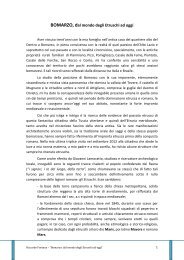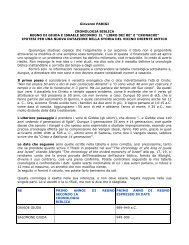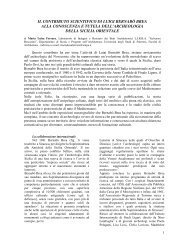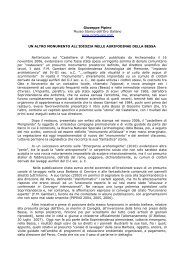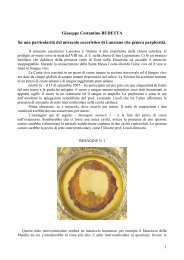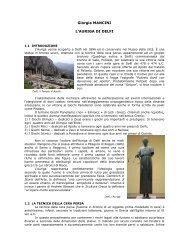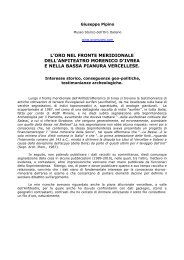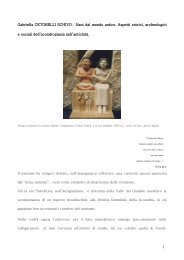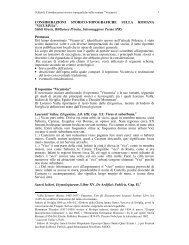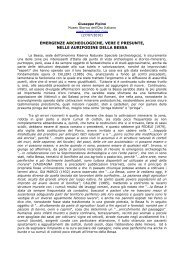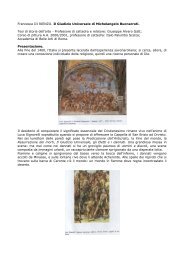COME ABBIAMO TROVATO L ARCA DI NOE.pdf - Auditorium
COME ABBIAMO TROVATO L ARCA DI NOE.pdf - Auditorium
COME ABBIAMO TROVATO L ARCA DI NOE.pdf - Auditorium
You also want an ePaper? Increase the reach of your titles
YUMPU automatically turns print PDFs into web optimized ePapers that Google loves.
ENCYCL. BRITANNICA<br />
VOL 5 PAG.97 - 1966 -<br />
The Central Caucasus extends for more than 125 mi. between the<br />
two great volcanic peaks of Elbrus (18,481 ft.) and Kazbek<br />
( 16,558 ft.). In this section the range reaches its highest and most<br />
impressive dimension. The central range becomes split into two,<br />
consisting of parallel up folds of granite separated by a syncline of<br />
soft black schistose rocks. Of these two chains, that to the north includes<br />
the highest peaks, having, in an addition to Elbrus and Kazbek,<br />
the granitic heights of Koshtan –Tau (16,876 ft.) and Dykn-<br />
Tau (17,054 ft.). The southerly range, from Ushba to Uilpata, although<br />
it is on the average lower than that to its north, is the more<br />
continuous of the two, and forms the main watershed of the range.<br />
This is because the erosive power of the range is greater than that<br />
of those which flow southward, and as a result they have cut back<br />
through the northern range and dissected it into its separate peaks.<br />
The Central Caucasus, being the highest section of the range, feeds<br />
many glaciers, especially on the southern slopes where the rainfall<br />
is heavier and the snow line higher. Two of the three great military<br />
highways of the Caucasus cross the range in this division. They are<br />
the Ossetia military highway, from Alagir to Kutaisi, which runs<br />
from the valley of the Ardon, a tributary of the Terek, across the<br />
Mamison pass to the valley of the Rioni, and the Georgian military<br />
highways from Ordzhonikidze to Tbilisi, leading from the valley of<br />
the Terek across the Krestovy pass (also know in earlier writing as<br />
the Darial pass or Caucasian Gates) to the valley of the Aragvi, a<br />
tributary of the Kura.<br />
Following you will find the scientific explanation of the phenomenon:<br />
ENCYCL. BRITANNICA<br />
VOL. 15 PAG. 299 -1966 –<br />
The Foehn (Chinook) Wind. – The foehn (fohn) wind is essentially<br />
a large-scale turbulence phenomenon. When a strong wind<br />
aloft blows across a major mountain range and is deflected<br />
downward in the lee of the mountains, the air reaches the lower<br />
elevations as an extremely warm, dry, gusty wind, which blows<br />
erratically because of turbulent action. The most extreme foehn<br />
effects are felt on the inland side of major mountain ranges, when<br />
warm maritime air blowing inland forcibly displaces cold continental<br />
air in the lee of the mountains. Under these conditions an<br />
oscillating quasi-stationary warm front is maintained dynamically<br />
in the lee of the mountains, the temperature changing by as<br />
much as 50° F. (26° C.) at sharp boundary between the warm<br />
and cold air mass. The development of heavy orographic precipitation<br />
on the windward side of the mountains may add considerable<br />
latent heat to the warm current, but the condensation forms<br />
are dissipated completely in the descending foehn wind. The<br />
warmth and dryness of a strong foehn, the Chinook (q.v.), east of<br />
the continental divide in North America are such that this wind<br />
may melt and evaporate as much as two feet of snow in 24 hours.<br />
~ 32 ~<br />
www.arkofnoah.it<br />
L’Arca di Noè può stare ad alta quota<br />
(4300 m) in una zona dove fa il<br />
gioco: si vede e non si vede….<br />
In altre parole se non ci fosse la Catena<br />
del Caucaso, per fare il gioco<br />
“si vede/non si vede”, l’arca di Noè<br />
si doveva trovare a 2800 m di altezza.<br />
Se fosse stato così, ognuno poteva<br />
dire che era una normale costruzione<br />
e non l’Arca di Noè…<br />
Quindi per avere l’Arca a 4300 m<br />
Dio ha modellato non solo la regione<br />
dell’Ararat (300 km circonferenza),<br />
ma Dio ha modellato anche la possente<br />
Catena del Caucaso, (lunga<br />
1200km- larga 200km) Amos 4: 13<br />
FIG 9 – FOEHN WIND CIRCULATION WITH CONDENSATION FORMS<br />
Fig. 9 represents schematically the circulation and the condensation<br />
forms that are typical of a strong foehn wind development<br />
on the eastern slope of the Rocky Mountains between<br />
warm maritime tropical air from the west coast and cold continental<br />
polar air in the interior of the North American continent.<br />
This region is noted for some of the most extreme foehn<br />
wind contrasts in the world, but conditions only slightly less<br />
extreme in character are observed north of the Alps in western<br />
Europe, north of the Himalayas in central Asia, east of the<br />
Andes in the southern portion of South America and many other<br />
regions. The foehn wind is always a warm wind whose descent<br />
is dynamically forced, in contrast with the cold, gusty,<br />
drainage winds whose descent is gravitational (see MOUN<br />
TAIN METEOROLOGY).<br />
The same phenomenon happens to Mount Ararat region because of Central Caucasus chain!...



